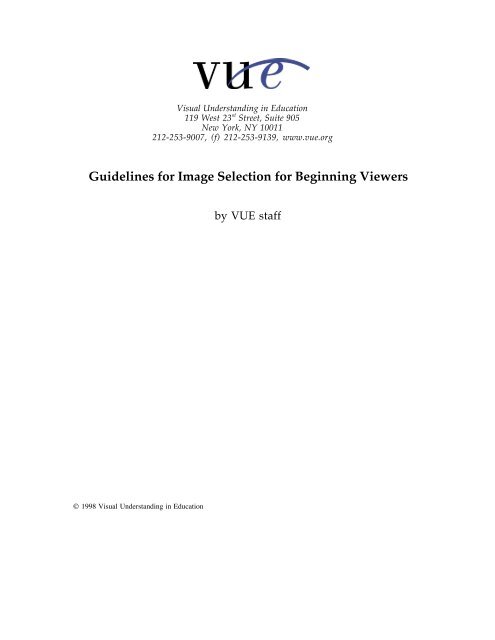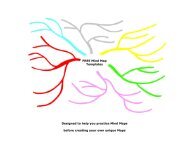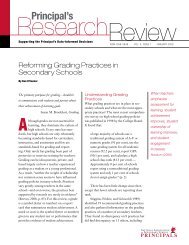Guidelines for Image Selection for Beginning Viewers - eStaffRoom
Guidelines for Image Selection for Beginning Viewers - eStaffRoom
Guidelines for Image Selection for Beginning Viewers - eStaffRoom
You also want an ePaper? Increase the reach of your titles
YUMPU automatically turns print PDFs into web optimized ePapers that Google loves.
Visual Understanding in Education<br />
119 West 23 rd Street, Suite 905<br />
New York, NY 10011<br />
212-253-9007, (f) 212-253-9139, www.vue.org<br />
<strong>Guidelines</strong> <strong>for</strong> <strong>Image</strong> <strong>Selection</strong> <strong>for</strong> <strong>Beginning</strong> <strong>Viewers</strong><br />
by VUE staff<br />
© 1998 Visual Understanding in Education
<strong>Guidelines</strong> <strong>for</strong> <strong>Image</strong> <strong>Selection</strong> <strong>for</strong> <strong>Beginning</strong> <strong>Viewers</strong>, © 1998<br />
Choosing objects to introduce beginning viewers to the wonders of art<br />
should be as thoughtful a process as choosing literature to engage the incipient<br />
reader. If the educator places a value on the viewer’s developing a solid rapport<br />
with art, based on direct, personal connection, then thinking about what art is<br />
appropriate <strong>for</strong> them makes sense.<br />
The following guidelines are meant to aid the selection of images that lead<br />
to productive teaching <strong>for</strong> beginning viewers, whether thinking about the<br />
objects included in a museum visit or as part of materials prepared <strong>for</strong> classroom<br />
teaching. They are based on the premise that aesthetic learning occurs when the<br />
viewing experience addresses the needs and concerns of viewers, and<br />
appropriately challenges their abilities. The recommendations draw on Abigail<br />
Housen’s research into the viewing process and on her Stages of Aesthetic<br />
Development. The in<strong>for</strong>mation she has derived from studying viewers’ thinking<br />
enables us to link image choices to beginning viewers’ interests, strengths, and<br />
areas of potential <strong>for</strong> growth.<br />
One challenging aspect of choosing art <strong>for</strong> beginning viewers is realizing<br />
that not all art is the same, that not all objects are equally interesting to all<br />
viewers, and equally accessible in terms of meaning. In truth, objects lumped<br />
together as art are enormously diverse in content, intention, style, materials, and<br />
so <strong>for</strong>th. What is easily readable in one culture is obtuse in another. Some art is<br />
dense with in<strong>for</strong>mation, multilayered, and/or symbol-laden, other is patently<br />
decorative; understanding much of it demands certain prerequisite knowledge.<br />
Some art is emotionally expressive, some narrative and/or naturalistic; other is<br />
abstract, iconographic, stylized or idealized--in each case <strong>for</strong> different reasons,<br />
and most of it begging certain literacies <strong>for</strong> accurate “decoding”. The meaning<br />
and even the purposes of much art is speculative and subject to reasonable<br />
interpretation only by those who have studied it <strong>for</strong> years. Much art, including<br />
religious objects as well as some recent art, was intended <strong>for</strong> an audience that<br />
specific shared in<strong>for</strong>mation and attitudes, and remains truly available only to<br />
those who gain that knowledge.<br />
One assumption of this guide is that early viewing is best taught by<br />
activating learners--helping them look carefully, think about what they see, and<br />
articulate their responses to it. We feel that this is most productively done in the<br />
context of discussions among groups of peers--people with equal experience and<br />
exposure to art, who there<strong>for</strong>e speak the same language, as it were. In<br />
discussions aided by a facilitator, individuals can overcome their own limitations<br />
by sharing observations and insights with others. A group of people brings a<br />
breadth of in<strong>for</strong>mation and experience to the process, even if it is not experience<br />
with art. Importantly, the synergy of people adding to each other’s observations<br />
and bouncing ideas off one another enables a “group mind” to find possible,<br />
plausible meanings in unfamiliar images much more productively than any<br />
individual alone could do. Through group process, the individual’s possibilities<br />
are enhanced significantly.<br />
Visual Understanding in Education • 119 West 23 rd Street, Suite 905 • NY, NY 10011 • 212 253 9007 2
<strong>Guidelines</strong> <strong>for</strong> <strong>Image</strong> <strong>Selection</strong> <strong>for</strong> <strong>Beginning</strong> <strong>Viewers</strong>, © 1998<br />
Accessibility<br />
<strong>Beginning</strong> viewers make sense of what they encounter based on what<br />
they already know, thus one essential requirement <strong>for</strong> art images introduced to<br />
them is accessibility: are they likely to recognize what they observe Can they<br />
make reasonable associations with it based on what they already know Pictures<br />
should thus include identifiable and reasonably familiar people, actions,<br />
interactions, settings, and emotions. <strong>Viewers</strong> should be able to glean what they<br />
can from the objects without expert intervention, learning to trust that most art<br />
can be interpreted to a meaningful degree through examination, association, and<br />
deduction. What assists the beginning viewer is the sense that they are "getting<br />
it right.” Puzzling them is useful, but stumping them is not.<br />
Expressive content<br />
The images selected must be open to interpretation: they should contain a<br />
number of valid readings, and several possible meanings, even levels of<br />
meaning. This allows an intriguing challenge, and it also justifies a range of<br />
viable view points, recognizing that a characteristic beginning viewer behavior is<br />
ideosyncracy and personal reading. The more a work is open to interpretation,<br />
the more likely the viewer’s intuition is reasonable. At the beginning, images<br />
that are quickly captivating, and clear enough given a surface reading, are<br />
acceptable; but quickly, as confidence builds and interest in probing increases,<br />
pictures that are less clear are appropriate, functioning to encourage speculation,<br />
questioning, and complex interpretations.<br />
Narrative<br />
Housen has found that beginning viewers look <strong>for</strong> stories in art, even<br />
when they are not there. Our selection should give them ample opportunity to<br />
exercise this instinct and skill by providing images in which the artist intended a<br />
story to be found. Look <strong>for</strong> stopped action, dialogues, and pregnant moments,<br />
often found in“genre” scenes and images of family, play and work. Having<br />
“human interest" may be a way of describing the sought-after factors.<br />
Familiarity with the story’s elements is an issue here, so that viewers read the<br />
intended story, rather than one created entirely of their own fancy. It is<br />
important <strong>for</strong> beginning viewers to conclude a discussion thinking that they had<br />
legitimate insights; the older the group, the more likely they are to be suspicious<br />
of a process where many answers are correct; they are accustomed to a pattern<br />
of defined right and wrong, and it is there<strong>for</strong>e helpful at the end of a discussion<br />
(in the event that the question comes up) <strong>for</strong> the teacher to be able to say, yes,<br />
you did understand this picture in the way the artist wanted you to--or at least<br />
that the artist would be likely to accept the interpretations given. This is where a<br />
knowledge of art history and criticism is very useful: making selections with the<br />
artist’s or culture’s intentions in mind.<br />
Visual Understanding in Education • 119 West 23 rd Street, Suite 905 • NY, NY 10011 • 212 253 9007 3
<strong>Guidelines</strong> <strong>for</strong> <strong>Image</strong> <strong>Selection</strong> <strong>for</strong> <strong>Beginning</strong> <strong>Viewers</strong>, © 1998<br />
Diversity<br />
It is very much to the point to include art that is diverse in time and<br />
culture, in part because it is important <strong>for</strong> the beginning viewer to have<br />
experience at finding meaning in a wide range of art, even if they are little aware<br />
of it. Nevertheless, as you select, you must again consider each work’s relevance<br />
to particular viewers. Are they likely to be able to identify and accurately<br />
understand key elements, based on their shared experiences A good rule of<br />
thumb is that more than half of the content should be accurately "decodable"<br />
(“gotten right”)--given, of course, careful attention and thoughtful discussion.<br />
Many Japanese prints, Persian art and Medieval secular art qualify, <strong>for</strong> examples.<br />
Overall diversity should be sensitive to gender and racial representation as well<br />
as geography, ethnicity and the span of history.<br />
There are many good reasons <strong>for</strong> selecting images diverse in time and place:<br />
• diversity increases appreciation both <strong>for</strong> subjects and values that are specific<br />
to one culture as well as those that run through many;<br />
• history can be made concrete through art, something that gains in<br />
importance over time;<br />
• variety allows <strong>for</strong> more people to find their interests and preferences<br />
represented;<br />
• unfamiliar art can indicate that there are people and places who see things<br />
their own way, perhaps quite differently from you.<br />
Realism<br />
Stylistically, most of the varied <strong>for</strong>ms of realism--from naturalism and<br />
romanticism to expressionism and various <strong>for</strong>ms of stylization and idealization--<br />
will be most useful. In the case of photorealism, it depends on how interesting<br />
and relevant the subject is. Surrealism can be appreciated, especially after some<br />
earlier experience with images whose logic corresponds to the "real world."<br />
Series/themes<br />
Generally, images should be presented in series, united by some visual<br />
elements or themes. For beginner viewers, this suggests an obvious link, such as<br />
mothers and children, people playing or working, not an underlying subtlety<br />
such as joy. It is not, however, assumed that beginner viewers will notice such<br />
interconnections. Still, given the existence of much continuity and transcendence<br />
in themes, ideas, subjects and values in art throughout time and cultures, it is<br />
useful to structure this concept into any organized presentation of art.<br />
Visual Understanding in Education • 119 West 23 rd Street, Suite 905 • NY, NY 10011 • 212 253 9007 4
<strong>Guidelines</strong> <strong>for</strong> <strong>Image</strong> <strong>Selection</strong> <strong>for</strong> <strong>Beginning</strong> <strong>Viewers</strong>, © 1998<br />
Media<br />
Paintings, drawings, prints, photographs and sculpture (including reliefs)<br />
are all good choices <strong>for</strong> museum visits, although scale, glare and accessibility<br />
should be considered. You want to ensure that all participants can easily see the<br />
work under discussion.<br />
When making a selection of images to be discussed by way of slides or<br />
other reproductions, three-dimensional work should be downplayed including<br />
most decorative arts, architecture and site-specific sculpture, mostly because<br />
these do not translate well to reproduction, especially given the literal-ness of<br />
beginner viewers. The exceptions to this include reliefs and other sculptures that<br />
read well from one view.<br />
Paintings are useful because<br />
• they are ubiquitous through history and often thought of as the most<br />
important artistic medium of a culture;<br />
• they communicate by several means, including both subject and appearance;<br />
• they reproduce reasonably accurately.<br />
Some drawings and prints should be included because<br />
• students should become familiar with these important media;<br />
• students own work is most likely to be in these media;<br />
• these media illustrate artists' technical processes most visibly.<br />
Photographs should be included because<br />
• one cannot become a visually literate person today without learning to<br />
interpret photos; we see great numbers of them, mostly without considering<br />
the ways they are used to manipulate our responses;<br />
• they are often easy to read which makes them especially accessible to<br />
beginning viewers;<br />
• they are also very important as a bridge to understanding what artist's do.<br />
Of all media, photographic processes are the easiest <strong>for</strong> the student to<br />
emulate; they can imagine looking through a camera, shifting position to<br />
include more or less in an image, or to show it from an unusual position.<br />
Through this, it is easy to begin thinking about what choices artists make in<br />
terms of subjects and presentation, what they might be intending <strong>for</strong> us to<br />
think because of these choices, and so <strong>for</strong>th. Moreover, they can themselves<br />
take pictures that look as they want them to, harder with drawing and<br />
painting.<br />
Visual Understanding in Education • 119 West 23 rd Street, Suite 905 • NY, NY 10011 • 212 253 9007 5
<strong>Guidelines</strong> <strong>for</strong> <strong>Image</strong> <strong>Selection</strong> <strong>for</strong> <strong>Beginning</strong> <strong>Viewers</strong>, © 1998<br />
Artistic genre<br />
Various categories of art (land-, sea- and town/city-scapes,<br />
portraiture/self portraits) should each be given some attention, although<br />
“genre” scenes will dominate <strong>for</strong> beginner viewers. It is not assumed that<br />
viewers will acknowledge or even appreciate this diversity. However, if they are<br />
continuously being exposed to a range of in<strong>for</strong>mation, the groundwork will be<br />
there <strong>for</strong> conscious awareness and appreciation later.<br />
Key artists and works<br />
Artists in whom some collective pride is taken should be represented, as<br />
well as works that are particularly well known. Decisions of this kind are not<br />
particularly important to the viewer, but they help legitimize this approach to<br />
teaching to those more familiar with art than with the needs of beginning<br />
viewers--and they also help the student in learning the canons of art history if<br />
and when s/he becomes interested in doing so.<br />
Sequences<br />
Once a selection is made, putting the images in a sequence leading from<br />
ones that are simpler (where there are clearer and fewer possible meanings,<br />
fewer details, less density of content) and working toward more complex ones<br />
(where there is greater ambiguity of meaning, where ferreting out signifying<br />
details is more time consuming, where more of the meaning is communicated<br />
through style and materials than through iconography or subject, where<br />
symbolism and metaphor are more important). The number of images depends<br />
on the age and experience of the group, as well as its size, but considering that a<br />
good discussion takes from 12 to 20 minutes <strong>for</strong> a group of 20-25, somewhere<br />
between three and five images is a good number to plan <strong>for</strong> a single lesson, in a<br />
museum or out.<br />
Some thoughts on what might be avoided<br />
At beginner levels, it is important to avoid introducing art work that<br />
requires specialized in<strong>for</strong>mation in order to find meanings intended by the artist<br />
or culture. If a group cannot come up with a reasonably accurate interpretation<br />
of an object--as in the case of a symbol-laden representation of the Hindu god<br />
Siva, perhaps--then wait to introduce it. There will come a point when seeking<br />
in<strong>for</strong>mation is itself an intriguing pursuit. Historical, religious and mythological<br />
subjects, and ethnic-specific should be avoided because of their specificity: there<br />
are "correct answers," and misinterpretations can be misleading and intellectually<br />
specious. But again, there are many cases where the art object tells a story that<br />
makes sense even if certain particulars are not surmised or understood in detail.<br />
A single African ancestor figure may be inscrutable, but an African mother and<br />
child may communicate clearly its meaning, and even its magic.<br />
Illustrations, most photojournalism, cartoons and advertisements are<br />
seldom productive as images <strong>for</strong> beginning viewers because they allow <strong>for</strong> only<br />
one, or at best a narrow range, of interpretations.<br />
In general, certain subjects should be avoided, not because they are<br />
unimportant nor because under some circumstances they might not be discussed<br />
Visual Understanding in Education • 119 West 23 rd Street, Suite 905 • NY, NY 10011 • 212 253 9007 6
<strong>Guidelines</strong> <strong>for</strong> <strong>Image</strong> <strong>Selection</strong> <strong>for</strong> <strong>Beginning</strong> <strong>Viewers</strong>, © 1998<br />
productively by beginning viewers, but because school and other public<br />
situations involve too many variables to insure a positive experience. <strong>Image</strong>s<br />
depicting violence, specific political stances, specific religious imagery, nudity,<br />
overt sexuality and sensuality, and grotesque or macabre subjects may cause<br />
teachers difficulty because the values expressed are in conflict with a child's--or<br />
his or her own. The point of initial <strong>for</strong>ays into art is not to challenge deeply-held<br />
views nor to <strong>for</strong>ce conversation about taboo subjects, but to encourage looking,<br />
thinking and the articulation of well-founded opinions. Highly charged subjects,<br />
topics or even challenging techniques divert viewers from this focus.<br />
Abstractions are discouraged <strong>for</strong> beginner viewers not because they<br />
dislike them, but because they continue to look <strong>for</strong> stories in them--often<br />
idiosyncratic and imaginative fantasies--where none are suggested by the artist.<br />
Even <strong>for</strong> adult viewers, early experiences with art remain within the realm of the<br />
concrete and the obvious; thinking abstractly is an adult behavior, and also a<br />
sophisticated one that must be led up to.<br />
Still lives are not encouraged because the qualities one appreciates in a still<br />
life, like the qualities of an abstract painting, are not the ones that beginners are<br />
drawn to explore.<br />
Most decorative arts and architecture are difficult <strong>for</strong> beginner viewers to<br />
appreciate because so much of their meaning has to do with either abstract issues<br />
(status, power, wealth, space) or with the use of materials and crafts which are<br />
not the concerns of beginners. They will come to them in time.<br />
Specific considerations <strong>for</strong> younger viewers<br />
Very young viewers (5-7 year olds) are usually satisfied with finding,<br />
naming, listing, counting, scouting out more--and to some extent making up<br />
stories about what they see. Overall, the pictures should be fairly obvious and<br />
simple to allow <strong>for</strong> students to discuss them insightfully in terms of concrete<br />
observations--which is the arena in which they operate. They are not naturally<br />
inclined toward reasoning, seeking out levels of meaning, or pulling back and<br />
reflecting. Select accordingly. They should be able to interpret images accurately<br />
through a process of identifying what they see, including actions, gestures,<br />
expressions.<br />
When selecting <strong>for</strong> classroom materials, include at least one or two works<br />
that can be revisited during the museum visits.<br />
Visual Understanding in Education • 119 West 23 rd Street, Suite 905 • NY, NY 10011 • 212 253 9007 7
<strong>Guidelines</strong> <strong>for</strong> <strong>Image</strong> <strong>Selection</strong> <strong>for</strong> <strong>Beginning</strong> <strong>Viewers</strong>, © 1998<br />
<strong>Image</strong>ry<br />
• Active and animated, rather than quiet and pensive<br />
• Fairly spare in terms of how much is depicted<br />
• People and animals, more than things<br />
• Having one person or small groups, especially children, families<br />
• Equal gender representation, as well as racial/ethnic<br />
• Familiar activities<br />
• Familiar emotions<br />
• Values depicted should be shared by students<br />
• Clear settings<br />
• Timelessness<br />
• Colorful, cheerful and positive images will make teachers happy, and might<br />
well be recommended <strong>for</strong> the children as well<br />
Technique<br />
• Reasonably naturalistic realism<br />
• Paintings, drawings (especially in media children use themselves),<br />
photographs, folk art<br />
Diversity<br />
• Prioritize close to home, working outward: 25% might be "other"<br />
• Art works from other cultures should be highly similar in appearance to the<br />
"local" ones<br />
• Reasonable possibilities include Egyptian, various Asian, Islamic<br />
Themes<br />
• Family, parent(s) and child<br />
• Play, work, school<br />
• Love<br />
• Day/night<br />
• Seasons<br />
• City/town/country/water<br />
For the slightly more experienced, slightly older<br />
If they have very little experience with viewing art, most of what was said<br />
above still applies. There should be some differences to accommodate growth or<br />
age, however. For example, given experience with the VTS, they likely have a<br />
strategy <strong>for</strong> looking and will use it: they are likely to give detailed observations,<br />
will listen to other's points of view, and will explain their answers as a matter of<br />
course. They will not be content with listing what is concretely be<strong>for</strong>e them, but<br />
will be filled with stories.<br />
Answering the question, "What do you see that makes you say that" will<br />
have given students experience at thinking about their own thoughts--even if<br />
they are not conscious of this. This capacity may help prepare them <strong>for</strong> having<br />
second thoughts. They are likely to incorporate interpretations offered by their<br />
classmates into their own thinking. In any case, there is justification <strong>for</strong> selecting<br />
images that are more complicated, perhaps slightly more ambiguous, but that<br />
still can be “decoded” from the group looking together seriously and<br />
Visual Understanding in Education • 119 West 23 rd Street, Suite 905 • NY, NY 10011 • 212 253 9007 8
<strong>Guidelines</strong> <strong>for</strong> <strong>Image</strong> <strong>Selection</strong> <strong>for</strong> <strong>Beginning</strong> <strong>Viewers</strong>, © 1998<br />
searchingly. Some surrealist paintings are suitable--as in Dali, and possibly<br />
Magritte where the technique admirably represents the physical world, but the<br />
subjects push the imagination.<br />
There may be some paradoxical behavior. On the one hand, students'<br />
experience looking may allow them to enjoy pictures with imaginative elements;<br />
they will try to penetrate the picture's world. On the other, one may hear<br />
comments that compare an image to a student's concept of reality, as well as to<br />
the reality they perceive in most photographs--comparisons between what is<br />
depicted in an image and a student's concept of how it should be. This is<br />
inevitable, and might be played with in terms of picture selection.<br />
While it is early to push the task of comparing and contrasting, it is wise to<br />
include good comparisons in the selection to allow <strong>for</strong> it to happen naturally.<br />
For classroom materials, include a number of pictures that can be seen in<br />
museums and others that were seen earlier.<br />
<strong>Image</strong>ry<br />
• See above re: younger children; most of this still applies<br />
• Slightly increase the density of in<strong>for</strong>mation--details which contribute to the<br />
story and may complicate it<br />
• Increase the number of possible readings, ambiguity, also very slightly<br />
• Introduce some fantasy and surrealistic elements<br />
• Stay within the realm of the familiar in all cases<br />
• Social and family issues can be useful, although teachers sometimes become<br />
upset if too much “reality” enters the classroom<br />
• Avoid any images that might lead to invoking of stereotypes<br />
• Avoid subjects that get too much play in the popular media, like violence<br />
• Represent both genders and their interests conscientiously<br />
• Emphasize images where the character and personality of people comes<br />
richly into play, as well as complex settings, and begin to introduce issues that<br />
have to do with time: of day, of year not so much era<br />
Technique<br />
• All media that are generally recommended, especially photography<br />
• Realism still useful, including expressionism, surrealism, stylization<br />
Diversity<br />
• A wide range of art from many cultures and times<br />
• Representation of all racial and ethnic groups, being especially sensitive to the<br />
mix within the targeted audience<br />
Themes<br />
• More likely to be noticed, helpful<br />
• Comparisons and contrasts helpful<br />
Visual Understanding in Education • 119 West 23 rd Street, Suite 905 • NY, NY 10011 • 212 253 9007 9
<strong>Guidelines</strong> <strong>for</strong> <strong>Image</strong> <strong>Selection</strong> <strong>for</strong> <strong>Beginning</strong> <strong>Viewers</strong>, © 1998<br />
After several years of significant experience<br />
A switch in cognitive operations should be noticeable, making it likely that<br />
viewers are less content with subjectivity and personal readings. They may be<br />
more concerned about rules--what makes things appear as they do--perhaps<br />
expressing this in the <strong>for</strong>m of questions. Some issues that come up <strong>for</strong> them<br />
concern techniques and logic: things should appear as they are "supposed" to be.<br />
<strong>Viewers</strong> may be more conservative in their tastes than they were at the<br />
beginning; the so-called openness of beginners is actually a matter of ignorance<br />
(bliss...); after some experience, personal tastes, attitudes and values come into<br />
play. We should respect this if we want to keep them searching <strong>for</strong> meaning in<br />
new ways, instead of sidetracking them into arguments about what is right or<br />
wrong with a style, technique or subject. Values are likely to be of real concern,<br />
so this is not the time to challenge their moral or ethical views, as they might lose<br />
interest in art, and there<strong>for</strong>e the process we have been teaching.<br />
Two specific issues are predictable: craftsmanship, and who the artist<br />
might be. This is a good time to concentrate on images that address what the<br />
artist was either feeling or thinking. Regarding the latter, self portraits are<br />
recommended; it might be useful to have groups of pictures by single artists, to<br />
allow them to look more deeply into an individual's way of working, choicemaking,<br />
concerns. Regarding the <strong>for</strong>mer, photographs are useful, given the<br />
viewer’s familiarity with cameras, and his/her capacity to figure out many<br />
aspects of how they were made. Staying within the framework of realist<br />
tradition, it will nevertheless be useful to push the boundaries a little technically,<br />
too.<br />
Visual Understanding in Education • 119 West 23 rd Street, Suite 905 • NY, NY 10011 • 212 253 9007 10
<strong>Guidelines</strong> <strong>for</strong> <strong>Image</strong> <strong>Selection</strong> <strong>for</strong> <strong>Beginning</strong> <strong>Viewers</strong>, © 1998<br />
<strong>Image</strong>ry<br />
• Less active, more pensive, more interior content<br />
• Sparseness and focus still likely to be helpful in terms of in<strong>for</strong>mation (less to<br />
look at but more to think about than preceding year)<br />
• Paradox: general cultural statements useful (eg Robert Frank) also intensely<br />
personal comments (eg Kollwitz, Kahlo)<br />
• Familiarity still important<br />
• Obvious symbols--like skulls or flags--useful<br />
• Shared values critically important<br />
• Add "era" to the pictures in which time is a major concern, less timelessness<br />
• Sequences by one artist<br />
Technique<br />
• Realism; avoid "weird" techniques unless making a point<br />
• Photography, indicating variety of viewpoints and distances from subject,<br />
poses vs. candids, framing<br />
• Sequences needed showing divergent styles, craft<br />
Diversity, culturally<br />
• As above<br />
• Comparisons of different expressions of similar beliefs useful<br />
Themes<br />
• Very useful at this juncture, especially pairs that can be compared and<br />
contrasted<br />
Visual Understanding in Education • 119 West 23 rd Street, Suite 905 • NY, NY 10011 • 212 253 9007 11






